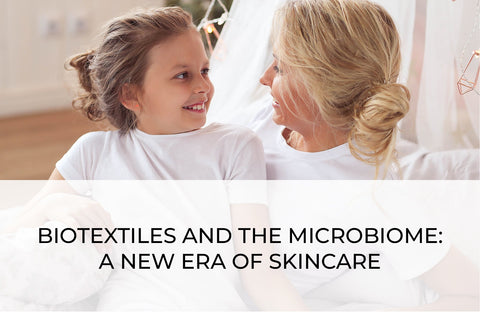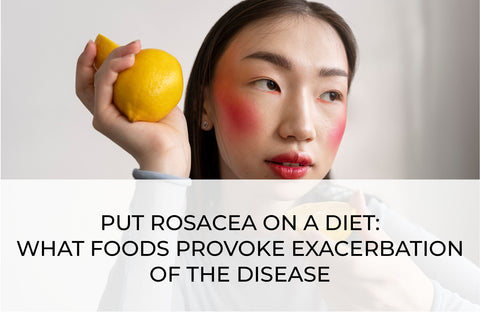PUT ROSACEA ON A DIET: WHAT FOODS PROVOKE EXACERBATION OF THE DISEASE

Rosacea is a chronic inflammatory dermatosis manifested by skin hypersensitivity, hyperemia, central facial erythema, papules, pustules, and sebaceous gland hyperplasia. The exacerbation of rosacea symptoms with the consumption of certain foods is an undeniable fact. Let's look at the current scientific evidence on the relationship between nutrition and rosacea.
Alcohol
The most potent trigger for rosacea manifestation and exacerbation is alcoholic beverages, namely wine (red wine has been reported to be a more powerful trigger than white wine). A large-scale study (n=82737) conducted by Li S. et al. examined the effect of alcohol consumption on the incidence of rosacea over 14 years. The authors found that participants (n=4945) with higher alcohol consumption had a significantly higher incidence of rosacea [1].
Presumably, the breakdown of acetaldehyde and acetone, metabolites of alcohol, produces histamine, causing dermal vasodilation and facial redness. An additional mechanism of alcohol-induced hyperemia is related to the opiate-like action of enkephalin.
Foods high in niacin
Niacin (nicotinic acid, vitamin B3) may be partly responsible for the flushes in rosacea patients. It is found in salmon, peanuts, tuna, liver, and chicken breasts. Niacin binds to Langerhans cell receptors, triggering the release of prostaglandins near capillaries, which leads to erythema, increased skin temperature, itching, and burning [2].
Spicy food
According to a 400-patient survey conducted by the National Rosacea Society (NRS), after eliminating capsaicin-containing spices, hot sauce, cayenne pepper, and red pepper from the diet, 75% of patients subsequently experienced a reduction in rosacea symptoms. Regarding the trigger mechanism, vasodilation and redness may be due to capsaicin activation of TRPV1 receptors [2].
Cinnamaldehyde
Cinnamaldehyde is found in tomatoes, citrus fruits, and chocolate. According to NRS studies, cinnamaldehyde activates the sensory nerves' transient receptor potential ankyrin 1 (TRPA1). This results in vasodilation, edema, erythema, and telangiectasias [2].
Caffeine
It was previously thought that drinking caffeinated beverages led to the manifestation and aggravation of rosacea symptoms. However, subsequent studies have restored the reputation of caffeine: both water and coffee were found not to cause redness at 22 °C. Erythema occurs after drinking hot beverages (60 °C). The high temperature, not the type of beverage, appears to be the primary trigger. It is believed that drinking hot beverages causes increased vasodilation and activation of the sympathetic nervous system, which leads to hyperemia and telangiectasias [3].
In a study by Li S. et al. involving 4945 patients, the effect of caffeine consumption on the incidence of rosacea was evaluated [4]. The authors found a clear inverse relationship between the risk of rosacea and caffeine: higher caffeine intake is associated with a lower incidence of rosacea. Caffeine appears to have a vasoconstrictive effect, reducing rosacea symptoms.
Foods high in histamine
Foods high in histamine (e.g., aged cheese, sauerkraut, wine, and fried meats) can act as triggers for rosacea symptoms. Histamine released by mast cells causes increased vascular permeability, tissue edema, blood flow, and endothelial barrier dysfunction. These effects are particularly pronounced in histamine intolerance. Histamine intolerance may be caused by an imbalance between the level of absorbed histamine and the body's ability to break it down [2].
Fatty food
A diet high in fatty foods (e.g., fatty meats, fried foods, and lard) is associated with a higher risk of rosacea. Fatty foods contribute to chronic inflammation and can also cause an imbalance in the synthesis of ceramides and hyaluronic acid and a relative deficiency of short-chain fatty acids. Consequently, the epidermal barrier is disrupted, and epidermal nerve fibers (C-type) are elongated. This can lead to rosacea symptoms such as pain, burning, and tingling [2].
Omega-3 fatty acids
Relief of ocular manifestations of rosacea (“dry eyes”) has been reported with supplements containing omega-3 fatty acids.
Dairy products
Data on the effect of dairy products on the pathogenesis of rosacea are contradictory. On the one hand, dairy products may have anti-inflammatory properties and contribute to the normalization of the gut microbiome. On the other hand, dairy products cause inflammation and exacerbate the manifestation of acne. Since acne and rosacea are chronic inflammatory dermatoses, it is unclear how dairy products can have opposite effects on these diseases. This question requires more in-depth research.
Probiotics
According to numerous scientific publications, probiotics contribute to the resolution of inflammation in treating chronic inflammatory diseases such as rosacea. Probiotics can attenuate vasodilation, edema, mast cell destruction, and TNF-α release and contribute to maintaining the integrity and repair of the epidermal barrier.
Thus, the most common triggers for rosacea are alcohol, spicy food, products rich in cinnamaldehyde (tomatoes, citrus fruits, chocolate), hot beverages, and histamine-rich foods (aged cheese, wine, roasted meats). According to several studies, dietary intake of probiotics and omega-3 fatty acids promotes rosacea regression. Nevertheless, dietary restrictions should be approached on an individualized basis so that patients avoid triggers that, in their experience, exacerbate the condition in their case.
References
- Li S., Cho E, Drucker A.M. et al. Alcohol intake and risk of rosacea in the US. J Am Acad Dermatol 2017; 76(6): 1061–1067.
- Searle T., Ali F.R., Carolides S., Al-Niaimi F. Rosacea and Diet: What is New in 2021? J Clin Aesthet Dermatol 2021; 14(12): 49–54.
- Bray E.R., Kirsner R.S., Issa N.T. Coffee and skin — considerations beyond the caffeine perspective. J Am Acad Dermatol 2020; 82(2): e63.
- Li S., Chen M.L., Drucker A.M., et al. Association of caffeine intake and caffeinated coffee consumption with risk of incident rosacea in women. JAMA Dermatol 2018; 154(12): 1394–1400.



































